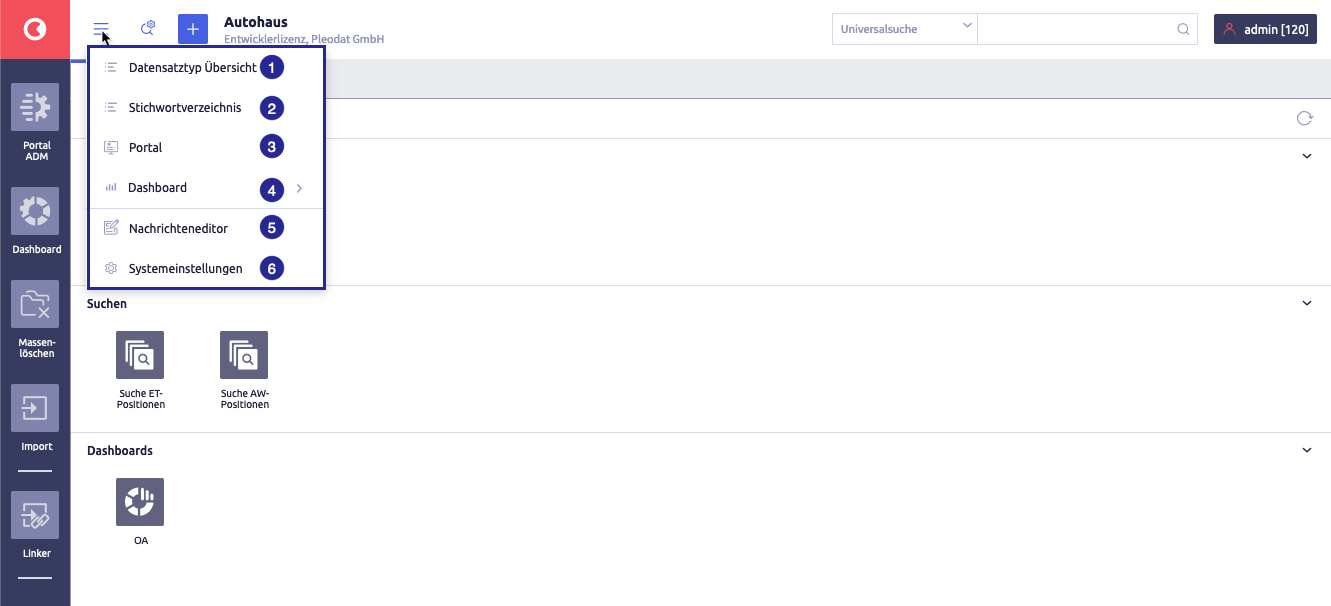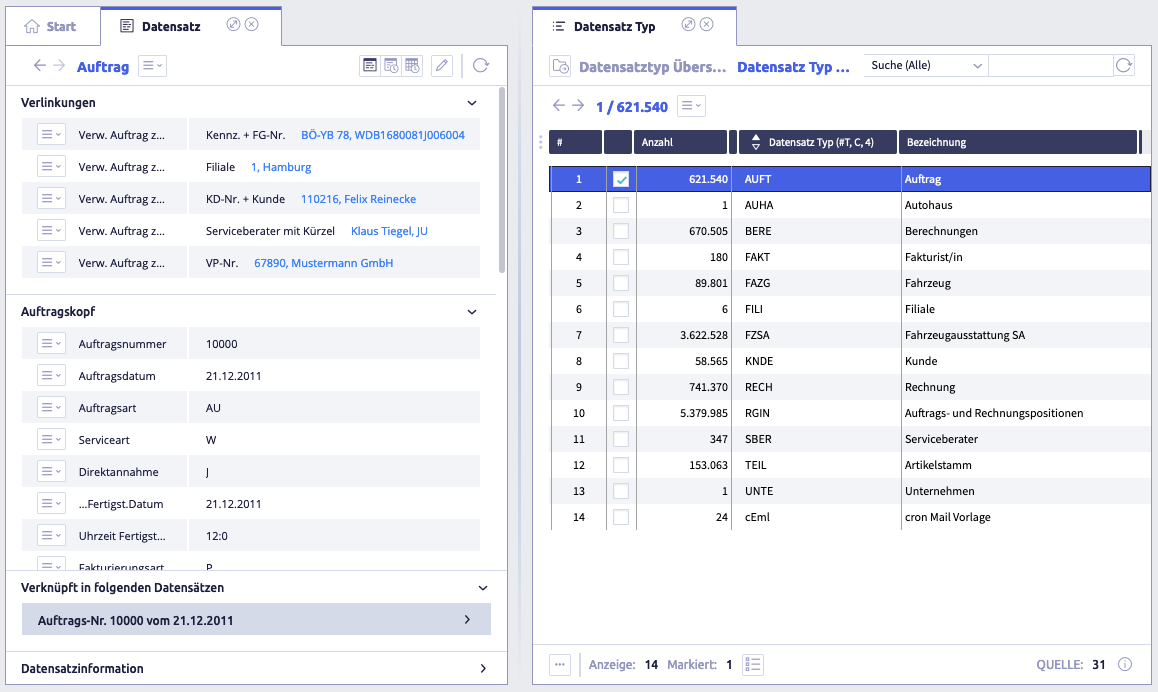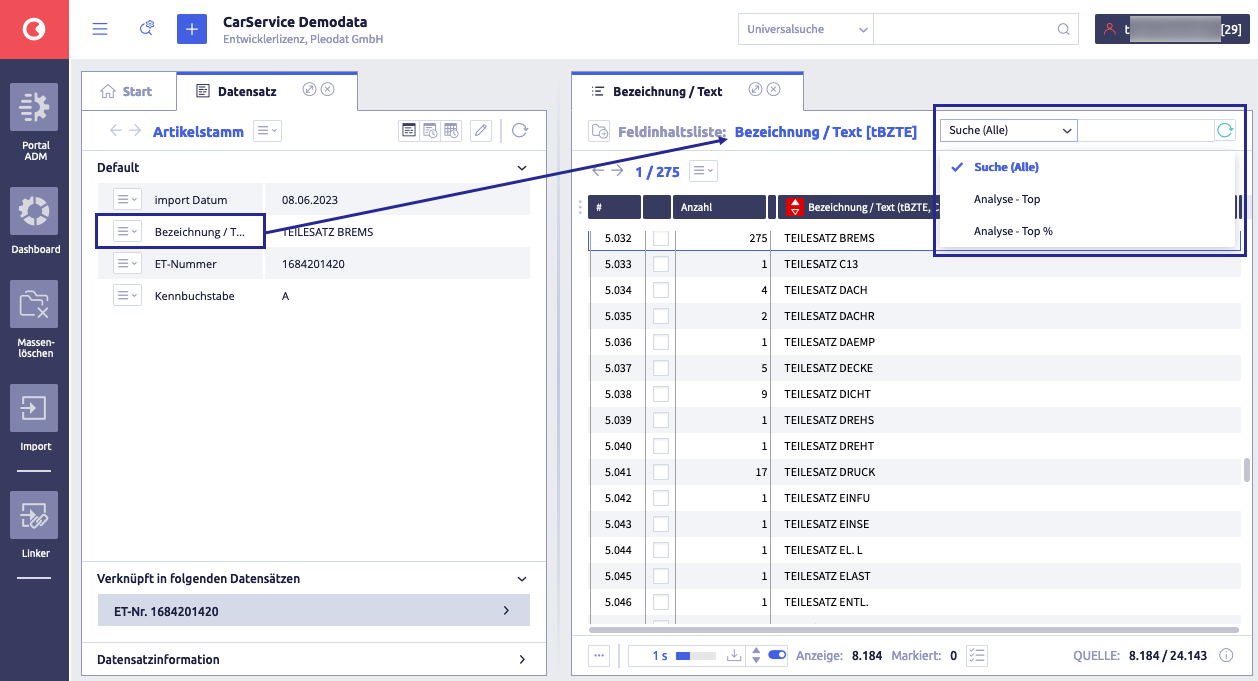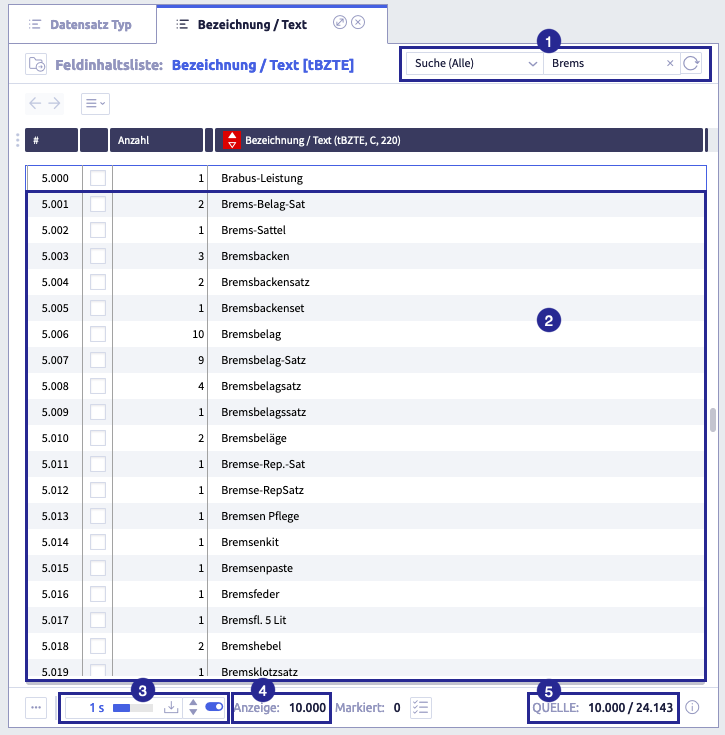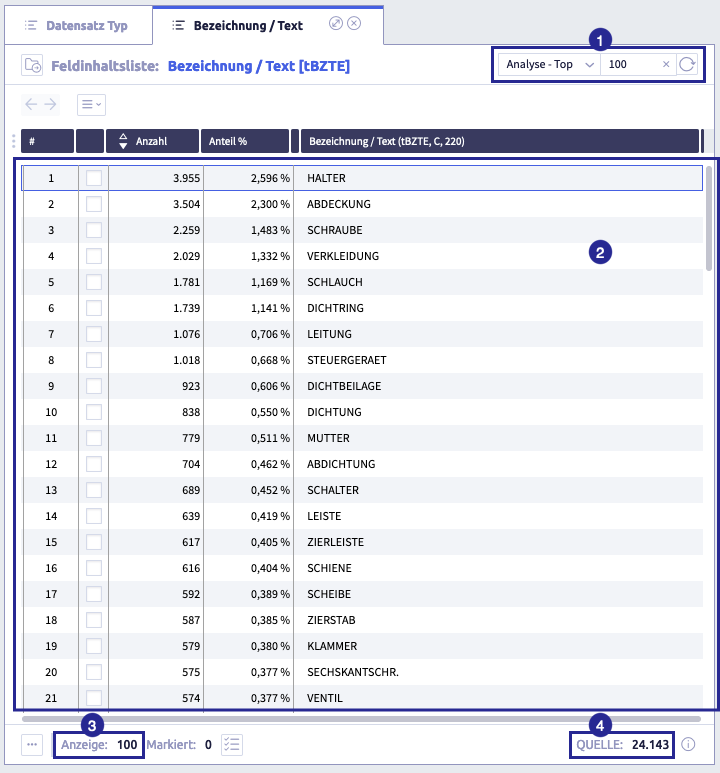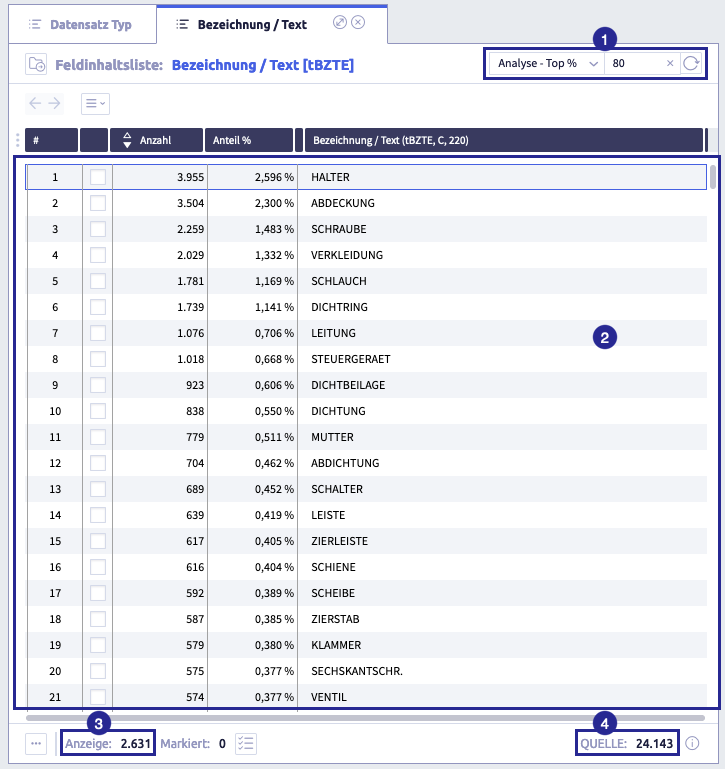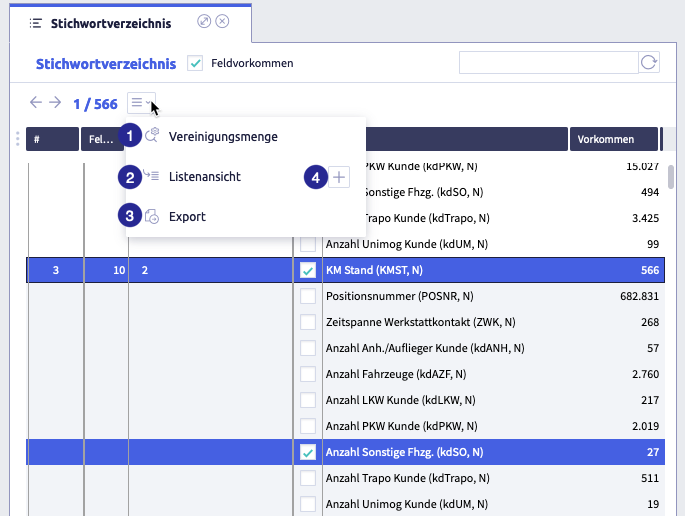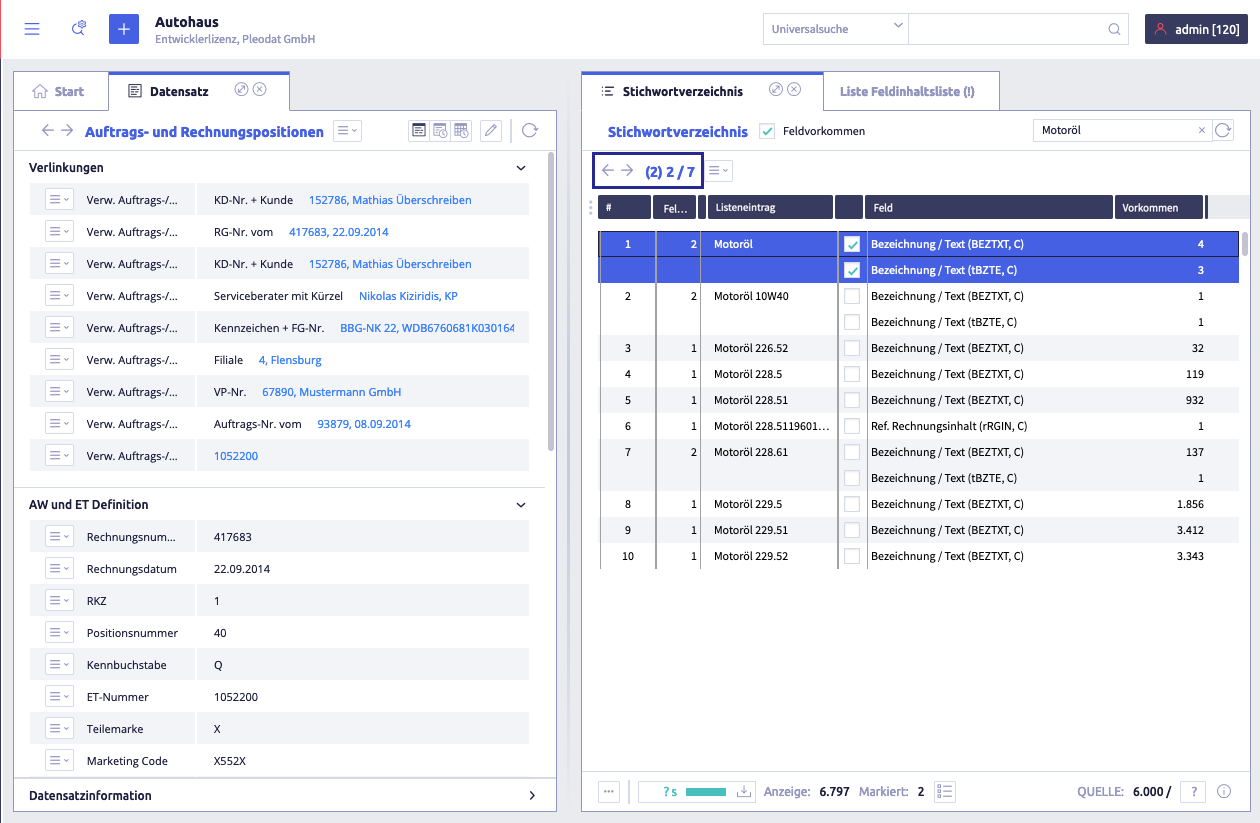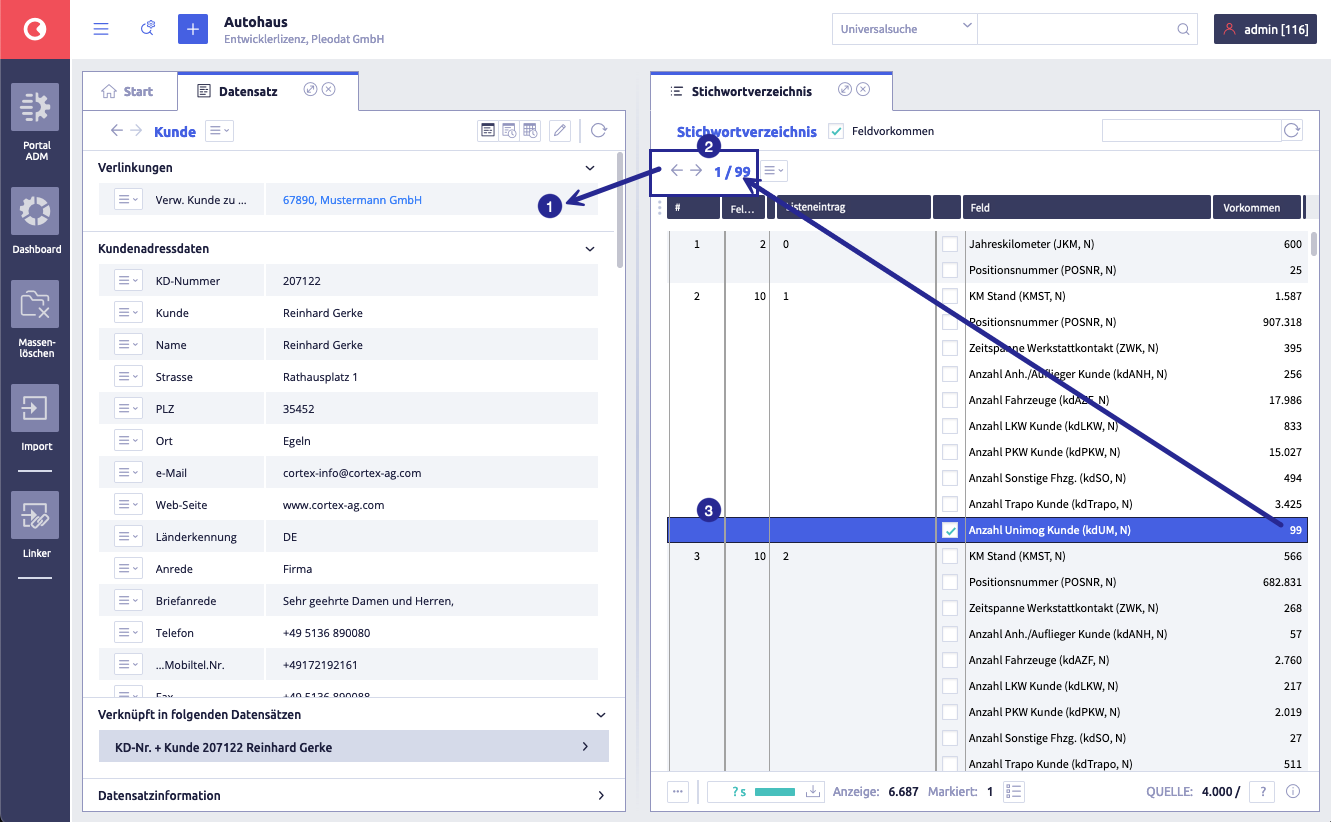Record types overview¶
The record type overview is a field dictionary for the system field record type.
- Only record types that contain at least one record are displayed in the record type overview.
- The list is preconfigured and cannot be edited.
You can do the following using the record type overview:
- open the record of the first record type
- open a field dictionary field dictionary of another field
- generate a list
- generate a union with other record types
- export information on record type(s) as CSV file
Open record type overview¶
-
click the hamburger menu at the top left of the header
-
select Record type overview
The overview with all records that contain at least one record will be displayed on the right.
-
select a record type by clicking on the row
The first record of the record type will be displayed on the left:
The image shows the first record (left) of the record type Order, to the right you can see the record type overview.
Overview of the record type overview¶
The image shows all elements of the record type overview: (1) button Select field ![]() , (2) selection Search and analysis with input field, (3) button Refresh field dictionary
, (2) selection Search and analysis with input field, (3) button Refresh field dictionary ![]() , (4) navigation through records, (5) selection menu
, (4) navigation through records, (5) selection menu ![]() for selected entries, (6) button Total row view / Single row view
for selected entries, (6) button Total row view / Single row view ![]() , (7) column header with sorting elements, (8) button context action for current row
, (7) column header with sorting elements, (8) button context action for current row ![]() , (9) information Display, (10) information Marked, (11) button Select all
, (9) information Display, (10) information Marked, (11) button Select all ![]() , (12) information Source, (13) information Total number
, (12) information Source, (13) information Total number
Table with all elements of the record type overview
| Name | Meaning | Note |
|---|---|---|
| button Select field | select a field to set the field dictionary of the field | |
| selection Searches and analyses with input field | searches and analyses are possible, top values in relative and percentage terms | refers to the displayed field dictionary record type |
| button Refresh field dictionary | ||
| arrows for navigating through the records of a selected record type | arrows are only active once a record is open | |
| selection menu for selected entries | options: - union - list view - export |
|
| button Total row view / Single row view | display of the list header | single row view shows the column headers of the main list total row view shows the headers of sublists, additional rows etc. |
| column # | row number | |
| column Checkbox-Column | selection of entries for list selection, export | |
| column Number | number of records of the record type | |
| column record type | abbreviation/synonym of the record type | field synonym, field type and field length are shown in brackets in the column header |
| column Name | name of the record type | |
| column header with sorting element | column Sort ascending/descending | |
| options for column header | sort and filter list | click the column header to open the options |
| button Context action for current row | using this button, object views for the current record type can be opened | in the system settings, object views are managed and record types assigned. |
| information on the number of displayed/loaded rows | ||
| information on the number of selected rows | ||
| button Select all | select all rows | |
| information number of sources | ||
| button Info | information on the loading time of the list |
Searches and analyses¶
Users can search and analyze the field dictionary to quickly find and select the desired information.
With an open field dictionary, click on Search(All). A selection with four options opens
Image search and analysis
The image shows the open field dictionary Description/Text[tBZTE,C,220] from the record Article master and the open selection for search and analytics.
The searches and analyses in the record type overview only refer to this list with all record types.
Searches¶
The field dictionary is sorted in ascending order. The search allows you to jump directly to a row in the field dictionary very quickly. The search result depends on the spelling of the search term, the input is case-sensitive.
Image: search
The image shows the example result of a search: (1) search field with input Brems, (2) search results, (3) button Load data
, (4) number of rows in the results list, (5) total number of different field contents
-
select Search (All) in the selection
-
enter a search term in the search field
Attention
- The search will only find exactly what you enter and is case-sensitive. Please make sure that your search term is entered accordingly.
- The entry for dates and times has the following scheme: YYYYMMDDhhmm, (example: the date 21.09.2011 is found like this: 20110921).
-
press the Enter key or click the button Refresh

The list will be refreshed.
Tips
- The field dictionary automatically jumps directly to the search term or to the next entry before the search term.
- The result list can be sorted.
-
select at least one result entry:
-
enter another search term if required
Analysis - top¶
The result of the analysis shows a list of the most recurring field contents of all records, sorted in descending order. The number and proportion refer to all records of this record type.
A numerical value is entered for this analysis, e.g. 100. The result list shows the 100 field contents with the highest occurrence in this field dictionary, sorted in descending order.
Image: Analysis Top
The image shows the example result of an analysis top: (1) analysis top field with input 100, (2) result list, (3) number of rows in the result list, (4) total number of different field contents
-
select Analysis - Top in the selection
-
enter any number
-
press the Enter key or click the button Refresh

A list of results opens.
- The length of the results list is limited to the number entered.
- The default setting in the input field is 1000.
Analysis - top percent¶
The result of the analysis shows a list of the most recurring field contents of all records, sorted in descending order. The number and proportion refer to all records of this record type.
A numerical value must be entered for this analysis, e.g. 10, where 10 stands for 10%. The result list shows the field contents with the largest occurrences in this field dictionary, which exceed the entered numerical value for the first time in the sum of the percentages (in the sample figure, the six largest occurrences have a percentage of 10.02%).
Image Top% analysis - here as Pareto analysis
The image shows the example result of a Pareto analysis (80%) with (1) analysis top% field and an input 80 with the button Refresh field dictionary
, (2) result list, (3) number of rows in the result list, (4) total number of different field contents
-
select Analysis - Top% in the selection
-
enter any numerical value between 0...100
You can also enter decimal numbers.
-
press the Enter key or click the button Refresh

A list of results opens.
The default setting in the input field is 80 (value for Pareto analysis).
Show occurrences in a (new) list view¶
Selection menu of the list
The image shows the selection menu for selected rows in the list using the example of the global dictionary: (1) union, (2) list view, (3) export, (4) list view in new list
-
select an entry
-
click the selection
 and select List view
and select List viewThe list view containing all records of the record type is opened in an additional tab next to the Record Type tab.
Information on how to work with lists and list views (sorting, filtering, etc.) can be found under simple lists.
Union of multiple entries¶
It will be possible to combine several entries. The combined set includes all records of the individual entries and can be displayed in a list view.
Selection menu of the list
The image shows the selection menu for selected rows in the list using the example of the global dictionary: (1) union, (2) list view, (3) export, (4) list view in new list
-
select more than one entry
-
click the selection
 and select Union
and select UnionThe following window opens:
Example of entries in the global dictionary, left: second record of the union set, right: result list with two selected entries.
The numerical values in the frame show from left to right: number of merged occurrences, number of the displayed records, number of all records of this union set.
-
open the individual records if required
-
open the list view
-
to dissolve the union, deselect the entries and click the button Refresh

Here's how it works:
Open a record for a selected entry¶
-
click the entry of a result to see the first record of this result
The following window opens:
Example of entries in the global dictionary: (1) current record, (2) navigation through the records, (3) selected result entry
-
to switch between the data sets, use the navigation arrows (2)
Information on how to work with the record view can be found here.
Export selected entries as a CSV file¶
The CSV export of the record type overview can be used for further (statistical) processing of the list.
Selection menu of the list
The image shows the selection menu for selected rows in the list using the example of the global dictionary: (1) union, (2) list view, (3) export, (4) list view in new list
-
select the rows you want to export
-
The CSV file will be downloaded and saved in the download folder (or the folder you set in the browser).
The file name will be generated automatically and is called Feldinhaltsliste.csv.
A list with the following information will be exported:
| Column | Meaning |
|---|---|
| number | number of records of the record type |
| record type (abbreviation(synonym), field type, number of characters) | abbreviation of the record type |
| name | name of the record type |
